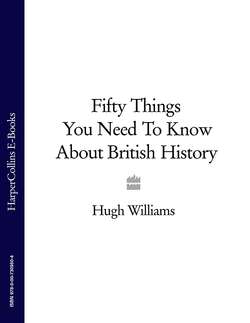Читать книгу Fifty Things You Need To Know About British History - Hugh Williams - Страница 7
Introduction
ОглавлениеWhen I was young we used to go on holiday to Anglesey, off the coast of North Wales. Our long drive would eventually take us across the Menai Bridge, Thomas Telford’s great feat of engineering constructed between 1819 and 1826 to speed up the journey to the port of Holyhead. When it was built no suspension bridge had been designed on such a scale before. Today it is a ‘World Heritage Site’. My father was Welsh and as we drove across he would recite a Welsh poem all about it. I cannot remember who it was by – probably the poet David Owen who wrote a number of poems about Menai – but I can remember that he tried to get my brother and me to recite it too. We never managed more than a few words. The Welsh language, despite our parentage, has remained a closed book to us. But sweeping across Telford’s beautiful masterpiece high above the waters of the Menai Straits, my parents’ ancient Austin looking forward like an exhausted horse to the end of the interminable drive, I felt a bit Welsh, a bit different and rather special. I felt I had roots. I was something more than just an ordinary little London schoolboy.
Over the past thirty years people in Britain have spent a lot of time returning to their roots. The fashion for devolution with the establishment of a parliament in Scotland and an assembly in Wales, combined with the long struggle to find political stability in Northern Ireland, have affected our sense of nationhood. Which comes first – our Britishness, our Scottishness, Welshness or Englishness? Meanwhile, beyond the shores of the United Kingdom, our national interests are being absorbed into the common objectives of the European Union and constantly tempered by increasing globalisation. Outside we are hurrying to be part of a bigger world: at home, it seems, we want to be part of a smaller one. Who we are and where we come from have become increasingly important as a shrinking world seeks to suck our national identity out of us.
This chapter goes in search of who the British are and where they came from. It begins with Stonehenge, an enigmatic monument to the people who inhabited the country in its earliest times, and as good a place as any in which to invest our sense of history.
The Romans were the first people to give Britain shape. They occupied it for 400 years, but after they withdrew the order they had created collapsed into chaos. Slowly, very slowly, order began to return. It came first through the messages of the Christian missionaries, particularly Saint Augustine, who brought back the ideas of Rome, by then a Christian city, to the island which had been abandoned 200 years before. It was enlarged and developed by the Anglo-Saxon kings, the greatest of whom was Alfred the Great, King of Wessex.
Britain succumbed to invasion for the last time in 1066 when the Normans became its rulers, destroyed the Anglo-Saxon way of life and started to lay the foundations of the medieval state. The Catholic Church and the monarchy held the country in their grasp until the Reformation broke them apart. Henry VIII’s dissolution of the monasteries in the sixteenth century was one of the most important acts in a process which would see the evolution of Britain into a nation state. Shakespeare helped give that nation its tongue.
In 1707 Britain joined with Scotland, but managed its relationship with its other neighbour, Ireland, far less successfully. The failure of the Home Rule movement in the nineteenth century would have disastrous consequences for both countries in the twentieth.
Today, in the twenty-first century, Britain is a part of Europe and shares its national aspirations with twenty-seven other countries. The island which carved its identity by withdrawing from the shifts and changes of a continent in turmoil has re-entered the arena from which it came. Once again Britain is replanting its roots.
